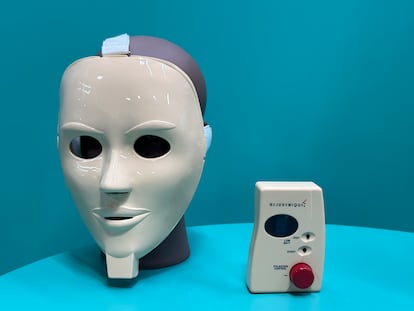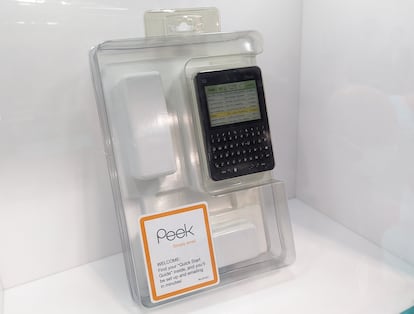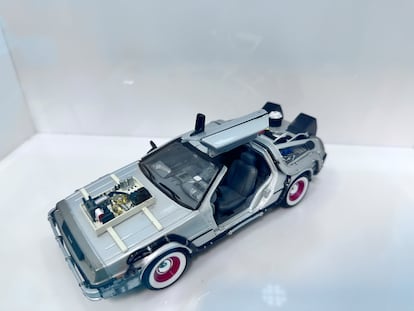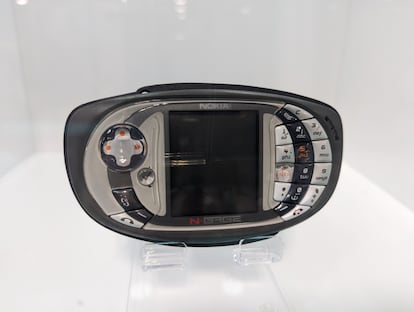A gadget just for tweeting, an anti-wrinkle face mask and other tech flops
Every once in a while, technology companies release products that become legendary for all the wrong reasons

Even tech giants such as Apple, Amazon and Nintendo can fail occasionally, just like any other company. “Many founders have this bias where they think they’re geniuses and everything that they are doing is super right,” says Narek Vardanyan, CEO of Prelaunch.com. However, that is not always the case, as can be seen in the “gallery of flops” that Vardanyan’s company created at CES 2023, the most important tech fair in the world. This exhibit display some of the biggest, most unexpected technological failures of the last decades.
A device just for tweeting
The TwitterPeek only worked with one social network: Twitter. To Vardanyan, who explains that 80% of products fail because there is no market for them, this is akin to having a car that can only take you to one place. The gadget, developed by the company Peek and launched in 2009 for approximately $200, was a failure simply because Twitter users were already getting smartphones that could tweet. “The TwitterPeek is so dumb it makes my brain hurt,” wrote an expert from the Gizmodo tech site at the time.

A face mask straight out of a horror movie
In 1999, the Rejuvenique company thought it would be a good idea to launch a face mask that would be right at home in a scary movie. It was meant to be strapped to a user’s head to try to reduce wrinkles and tone the facial muscles with electrical stimulation. Despite the fact that the FDA declared it unsafe, it still went on the market a year later. Its end was as enigmatic as the mask itself: it “mysteriously disappeared.”
A dizzying console
The Virtual Boy console, aimed at taking advantage of 3D graphics, became a headache for Nintendo. In addition to the fact that the 3D effect was not quite successful, it made the players dizzy. Its size didn’t help, either: something planned as a portable console ended up being a huge, heavy machine that was hard to carry around. Additionally, users had to lean forward while playing, which also caused neck pain. Nintendo halted this device’s production in 1996, one year after its launch.
A car with gullwing doors
The DMC-12, built between 1981 and 1982 by the DeLorean Motor Company, had wings, but could not take off. According to Prelaunch, it was a phenomenal car that failed due to poor management and marketing. The car – better known for its prominent screen time in the Back to the Future trilogy – stands out for its gullwing doors and polished stainless steel body.

Not-so-portable speakers
Apple introduced the iPod Hi-Fi in 2006 as a speaker system for the iPod that redefined the concept of a home stereo. However, as Prelaunch explains, the company abandoned it after 18 months, as it failed to meet sales expectations. Even though it produced quality sound and was fairly well received at launch, it was not as portable as the iPod, defeating its own purpose (not to mention the fact that there were cheaper options with better sound quality on the market).
An uncomfortable gaming phone
In Nokia’s imagination, the N-Gage was a win-win: a phone and a video game console, all rolled into one. The device, from 2003, was one of the first attempts to launch a portable gaming device in the mobile market. However, it ultimately failed due to an implementation error, according to Vardanyan. The company botched the design and created a product that was neither a comfortable phone nor a comfortable portable console. On top of that, changing games was an ordeal: the user had to remove the back cover and the battery.

A remote with more than 80 buttons
The Google TV Remote was an attempt to integrate television and internet. When it launched in 2012, the goal was to bring the search giant into the user’s living room. However, what was expected to be a great success ended up a total failure. The remote, made by Sony, had more than 80 separate buttons and controls – needless to say, it was not easy to use. “If you thought that Google TV would make watching the internet on your television as simple as clicking a button, you were half-right. It does involve a button. Actually, 81 of them,” declared The Guardian.
A smartphone preloaded with assumptions
Amazon founder Jeff Bezos announced in 2014 that the company would manufacture and sell the Fire Phone in order to compete with Apple and Samsung. The device, which received negative reviews from day one, stopped being sold a year later. Prelaunch explains that instead of conducting the proper research, Amazon simply made assumptions about what their customers cared about, how much they were willing to pay – even the apps they wanted. All of them incorrect, unfortunately.
Sign up for our weekly newsletter to get more English-language news coverage from EL PAÍS USA Edition
Tu suscripción se está usando en otro dispositivo
¿Quieres añadir otro usuario a tu suscripción?
Si continúas leyendo en este dispositivo, no se podrá leer en el otro.
FlechaTu suscripción se está usando en otro dispositivo y solo puedes acceder a EL PAÍS desde un dispositivo a la vez.
Si quieres compartir tu cuenta, cambia tu suscripción a la modalidad Premium, así podrás añadir otro usuario. Cada uno accederá con su propia cuenta de email, lo que os permitirá personalizar vuestra experiencia en EL PAÍS.
¿Tienes una suscripción de empresa? Accede aquí para contratar más cuentas.
En el caso de no saber quién está usando tu cuenta, te recomendamos cambiar tu contraseña aquí.
Si decides continuar compartiendo tu cuenta, este mensaje se mostrará en tu dispositivo y en el de la otra persona que está usando tu cuenta de forma indefinida, afectando a tu experiencia de lectura. Puedes consultar aquí los términos y condiciones de la suscripción digital.
More information
Archived In
Últimas noticias
More than 40 Democratic lawmakers urge Trump in a letter to stop his ‘attempts to undermine democracy in Brazil’
The journal ‘Science’ criticizes Trump’s anti-renewable energy policy: ‘The US is failing to benefit from its own innovations’
Cubans hope for a miracle as dengue and chikungunya spread
The long shadow of the father figure in the films of Rob Reiner
Most viewed
- Christian Louboutin: ‘Young people don’t want to be like their parents. And if their parents wear sneakers, they’re going to look for something else’
- Cartels in Mexico take a leap forward with narco-drones: ‘It is criminal groups that are leading the innovation race’
- ‘El Limones’ and the growing union disguise of Mexican organized crime
- Liset Menéndez de la Prida, neuroscientist: ‘It’s not normal to constantly seek pleasure; it’s important to be bored, to be calm’
- The low-cost creative revolution: How technology is making art accessible to everyone











































